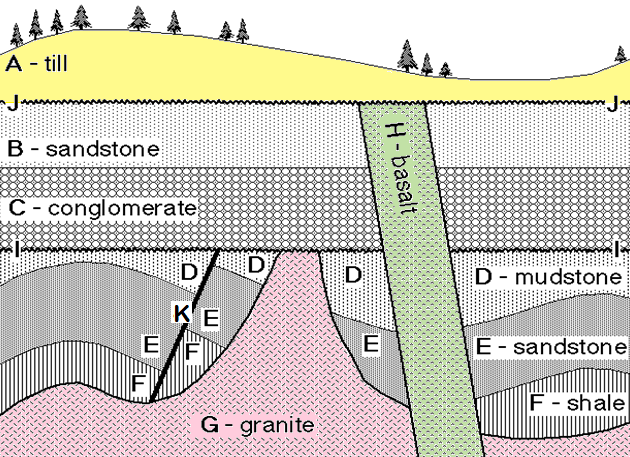Table of Contents
2-4 Geological Time
Read Chapter 8 in Physical Geology.
The various ways of measuring geological time are explained in Chapter 8 of the text. In Section 8.1, we look at how geological time is divided into manageable chunks, with names that are used around the world. Read through the description of the geological time scale. You don’t need to know the names and time limits of the eons, eras, periods, epochs, and ages, but you should be aware that the last 542 Ma is known as the Phanerozoic (Figure 8.1.3), and that it is divided into periods. You may already be familiar with some of the period names, such as Cambrian, Devonian, Jurassic, Cretaceous, and Quaternary. Currently, we are in the Quaternary Period, which started at 2.6 Ma.
Remember from Unit 1 that Ma means millions of years before the present, so 542 Ma means 542 million years ago.
In Section 8.2, we consider relative dating methods, including the use of inclusions and crosscutting relationships to determine the relative ages of rocks. These methods are in addition to the principles of superposition and faunal succession that were discussed earlier in this unit. Figure 2-11 shows a simplified cross-section of a series of sedimentary and igneous rocks. The order in which these were deposited, and the rationale for determining that order, are summarized in Table 2-1 that follows.

| Order | Feature | Explanation |
| 11 | A – till | This glacial deposit is the youngest. It overlies everything and is not cross-cut by anything. |
| 10 | J – unconformity | The rocks below this line were eroded to a flat surface prior to (or during) the deposition of A. |
| 9 | H – gabbro | The gabbro dyke cuts across everything else (except A and J), so it must be younger. |
| 8 | B – sandstone | The sandstone overlies the conglomerate, so it must be younger. |
| 7 | C – conglomerate | The conglomerate overlies all of the rocks beneath and is cross-cut only by the gabbro dyke. |
| 6 | I – unconformity | The underlying features (D, G, and K) have been eroded to a flat surface that cuts across all of them. |
| 5 | G – granite | The granite has intruded through all of the remaining features (D, E, F, and K), so it must be younger. |
| 4 | K – fault | The fault cuts across D, E, and F, so it must be younger than them. |
| 3 | D – mudstone | The mudstone overlies the sandstone, so it must be younger. |
| 2 | E – sandstone | The sandstone overlies the shale, so it must be younger. |
| 1 | F – shale | The shale is the lowest and oldest of the sedimentary layers, and the oldest rock in the diagram. |
Section 8.3 describes the concepts related to dating rocks using fossils. The underpinning of this technique is the principle of faunal succession that is illustrated on a large time scale (the latest Proterozoic and all of the Phanerozoic) in Figure 8.3.1. The evolution of all of the major large plants and animals took place during that time, as did the extinction of many important groups such as trilobites, ammonites, and dinosaurs.
In the early years of palaeontology, the identification of fossil assemblages only provided relative dates for different strata because the absolute ages of organisms were not known. However, since the early 20th century, geologists have been dating rocks using isotopic techniques, and it has been possible to assign actual dates to the age ranges of different fossil species. For some organisms, these age ranges are relatively narrow (e.g., less than a million years), whereas for others, they are several to even tens of millions of years. However, even where the ranges are long, it is common for a layer of rock to have several different fossils whose age ranges overlap, and thus the age of the rock can be quite well constrained, as illustrated in Figure 8.3.2.
You can practise narrowing down ages using fossil data in Exercise 8.2.
Section 8.3 also includes some discussion on the application of index fossils and biozone fossils for constraining the ages of rocks. An important feature of a good index fossil is that the species lived over a wide area, and thus can be used to correlate rock ages across several continents.
Isotopic dating (Section 8.4) depends on the fact that certain radioactive isotopes decay at a consistent and precisely known rate, and that by doing a chemical analysis of a rock or mineral sample, we can determine the proportions of the parent isotope (for example, potassium-40) and the daughter isotope (argon-40) to estimate the age of the sample. For the results to be useful we have to be confident that none of the daughter isotope was present in the rock or mineral when it was formed, and that none of the parent or daughter isotopes have been removed since the time of formation. Geologists have developed sampling techniques that help to ensure that this is the case.
Isotopic dating, best applied to igneous rocks, can tell us the time at which the magma cooled and crystallized. It can also be used with metamorphic rocks, but, in this case, we would be dating the time of metamorphism, rather than the formation of the original rock. As described in the textbook, isotopic dating cannot be used to date sedimentary rocks because they are made up of a variety of materials that are all older than the age of the rock. We can apply isotopic methods indirectly to dating sedimentary rocks if they are interbedded with volcanic rocks or if they are cut by igneous dykes, although in the latter case, we would only be able to say that the sedimentary layers are older than the dyke.
Complete Exercise 8.3 to get some practice with isotopic dating, and add this extra question: If the granite in question was in the form of a dyke that cut across some sedimentary rock layers, what could we say about the age of the sedimentary rock?
Section 8.5 describes a number of other methods for dating geological materials, and several more that are not included in this unit. As we’ll see in the next unit, magnetic dating techniques are very important with respect to plate tectonics. Exercise 8.4 will give you some experience with using these techniques.
Section 8.6 includes a discussion of the importance of having a real understanding of geological time. This knowledge is critical for anyone who wants to put past events into perspective, such as: What is the relationship between glaciation and human evolution and migration? Or how and why has the climate changed in the distant past? Or when did birds evolve?
Carefully read Section 8.6, and then complete Exercise 8.5.Then, answer the questions at the end of Chapter 8, and check your answers in the textbook.
This completes the notes for Unit 2.
Note if you are a registered student: If you haven’t already done so, now is the time to start working on Assignment 2 (go to the “Assignments Overview” area of your course). You should find most of what you need to complete this assignment in these unit notes and Chapters 5 to 8 of your textbook, but you might also need to refer to other sources of information.
You also should be finishing Labs 3 and 4 by now. Remember, do not send these labs to your Open Learning Faculty Member for marking. Answers to the lab questions are provided in your learning management


